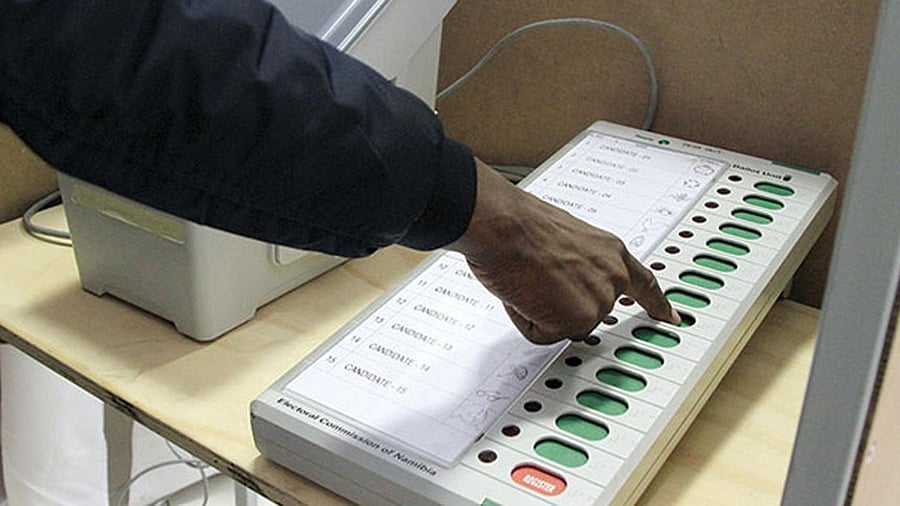
Representative image of a person voting through EVM.
Credit: DH Photo
For those questioning the electronic voting machine (EVM) system, the Election Commission of India (ECI) has provided tailor-made answers in the frequently asked questions (FAQs) section on its website. These answers and claims aim to convince readers that EVMs are infallible and safeguarded by comprehensive administrative, technical, and legal measures to ensure high levels of integrity and verifiability of the voting and counting system.
This has led some to believe that the EVM electoral process is entirely secure, incorporating multiple layers of security and verification, and that the voting process is structured for constant verification. They argue that any flaws lie with the candidates and polling agents, which could be resolved by political parties investing in better training for polling agents to maintain electoral integrity.
This is a fallacy. The layers of ‘verification’ built into the EVMs are for the machines and polling officials, not the voters, who are transferring their sovereignty. EVMs are ‘black boxes,’ and voting under this system does not meet essential ‘democracy principles’: ensuring voters can verify that their vote is cast as intended, recorded as cast, and counted as recorded. Moreover, the system lacks provable guarantees against hacking, tampering, and spurious vote injections. The design, implementation, and results of EVM hardware and software verification are not open to public or independent review.
According to the 2021 report “Is the Indian EVM and VVPAT System Fit for Democratic Elections?” by the Citizens Commission on Election—comprising leading national and international experts—the absence of end-to-end (E2E) verifiability renders the EVM system unfit for democratic elections.
To address this issue, the Supreme Court in 2013 ordered the introduction of Voter Verifiable Paper Audit Trail (VVPAT) systems, emphasising that a ‘vote is nothing but an act of expression which has immense importance in a democratic system.” But, in 2018, the ECI directed state chief electoral officers to verify VVPAT slips in only one randomly selected polling station per assembly constituency. This 0.5% sample size grossly defeated the purpose of installing VVPATs in all EVMs, effectively disregarding the Supreme Court order. Currently, only 2% of VVPAT slips are cross-verified, and this happens only after the results are virtually declared, sabotaging the intent behind VVPATs.
Recognising the implications for EVM integrity, civil society submitted a memorandum to the ECI signed by about 10,000 voters, making a specific demand: “A voter should be able to get the VVPAT slip in her hand and cast it in a chip-free ballot box for the vote to be valid. These VVPAT slips should be fully counted first for all constituencies before the results are declared.” No response has been received to this date.
Experts argue that the lack of E2E verifiability has facilitated spurious vote injections in various constituencies by hiking vote percentages in all phases of polling. The irregular spikes in voting percentages were observed during the recent Lok Sabha and state assembly elections in Haryana and Maharashtra. This issue, coupled with the failure of the ECI to abide by its legal obligations to provide Form 17-C—considered the ultimate proof of votes polled—to all candidates or their agents, has triggered the suspicion of a ‘stolen mandate’.
Another serious flaw in the EVM system is the reduction of sovereign, vote-casting citizens to mere ‘button-pressing robots’ without the ability to verify their votes. The process is so technical that it demands “comprehensive training” of not only polling agents but also the polling officials, numbering in the millions—a task that is practically infeasible given their diverse educational and professional backgrounds. Consequently, the touted “multiple layers of security and verification systems” in EVMs exist only in manuals and handouts, failing to be implemented effectively. This anti-democratic system opens the door to electoral rigging and manipulation.
In contrast, paper ballots do not have many of these flaws and, by and large, adhere to the essential ‘democracy principles’, which are what should really matter in democratic elections. Returning to paper ballots would ensure a genuine transfer of sovereignty through the electoral process and would safeguard India’s democracy from being reduced to the whims of machines from the will of the people.
(The writer, formerly of IAS, is coordinator, Citizens Commission on Elections)